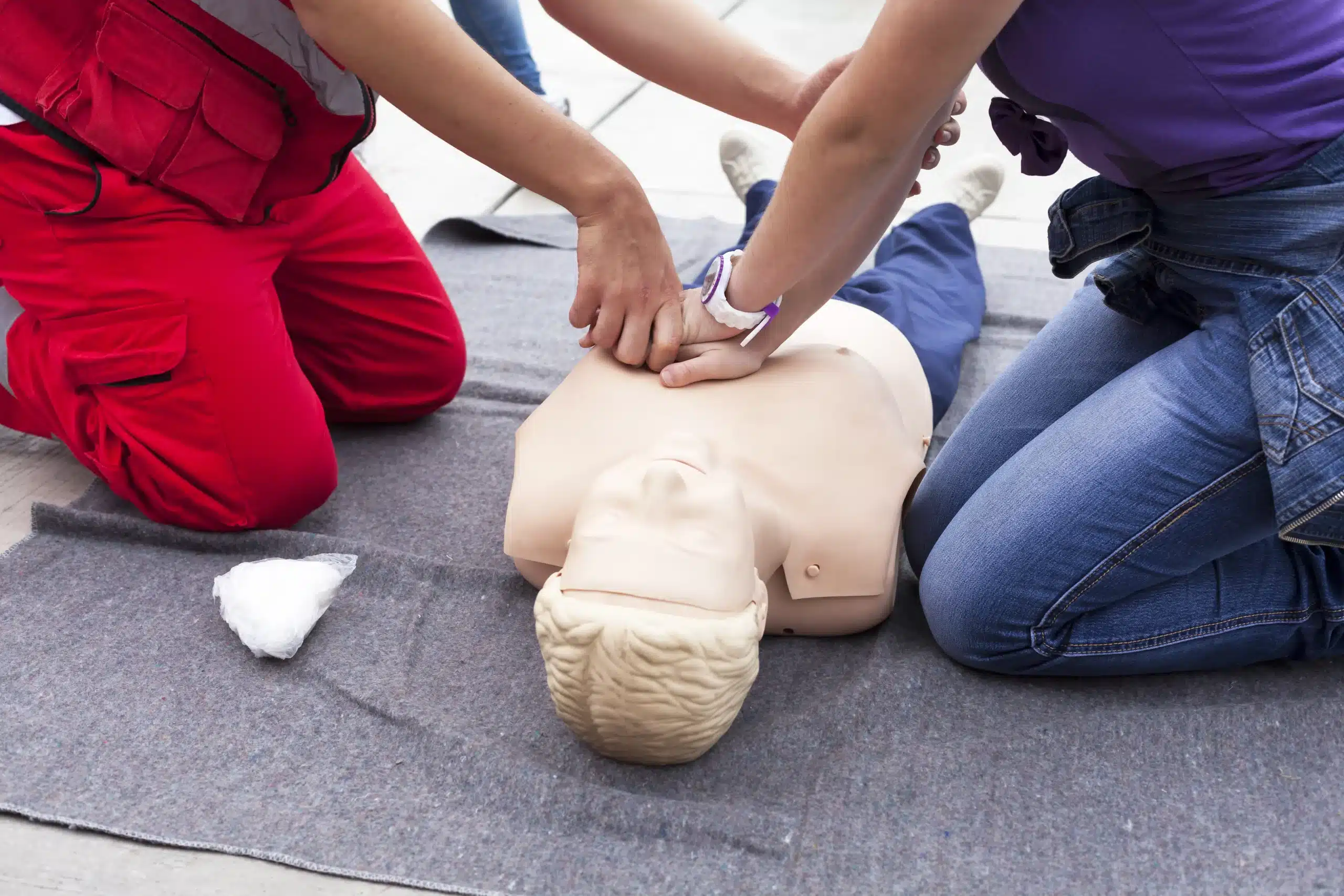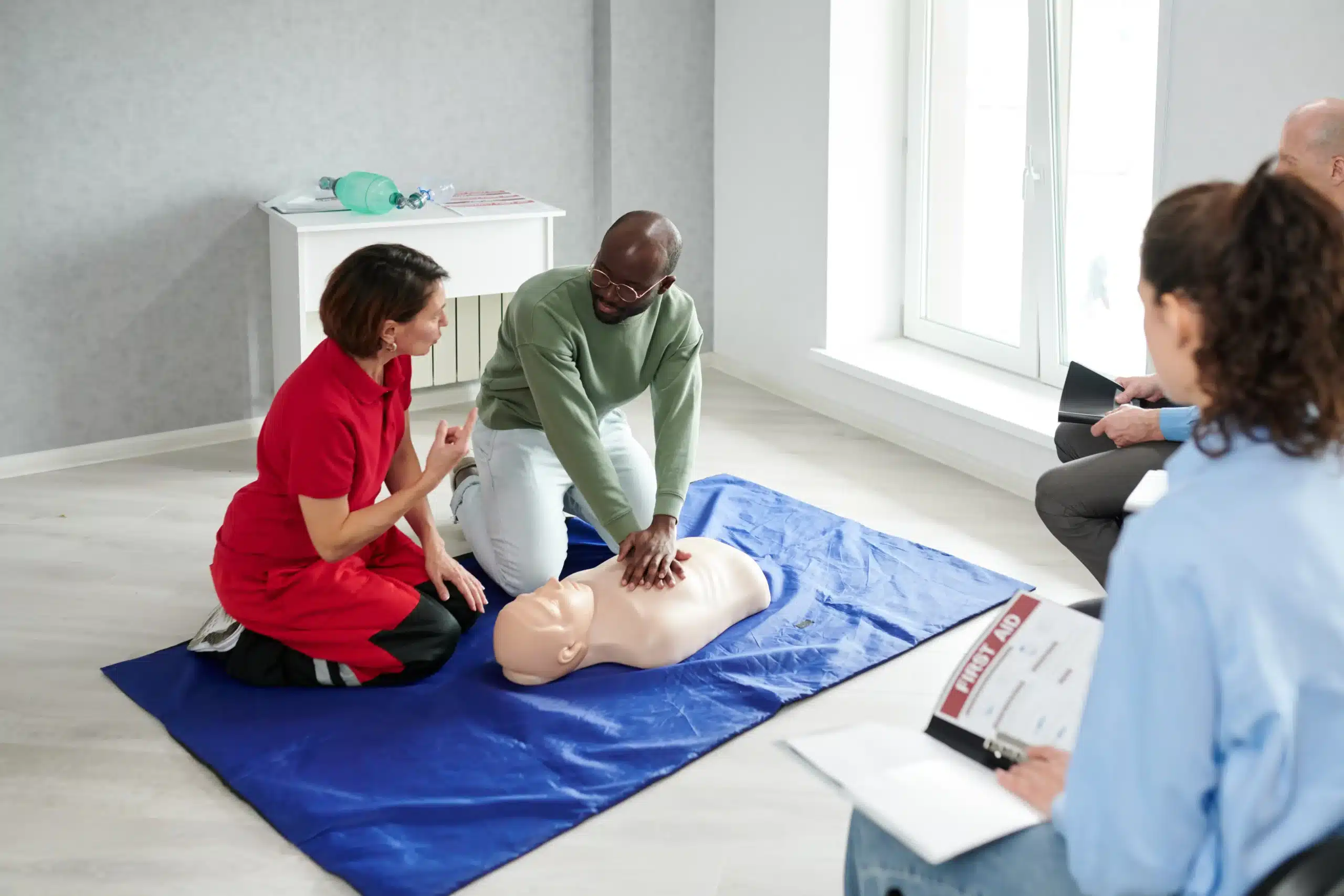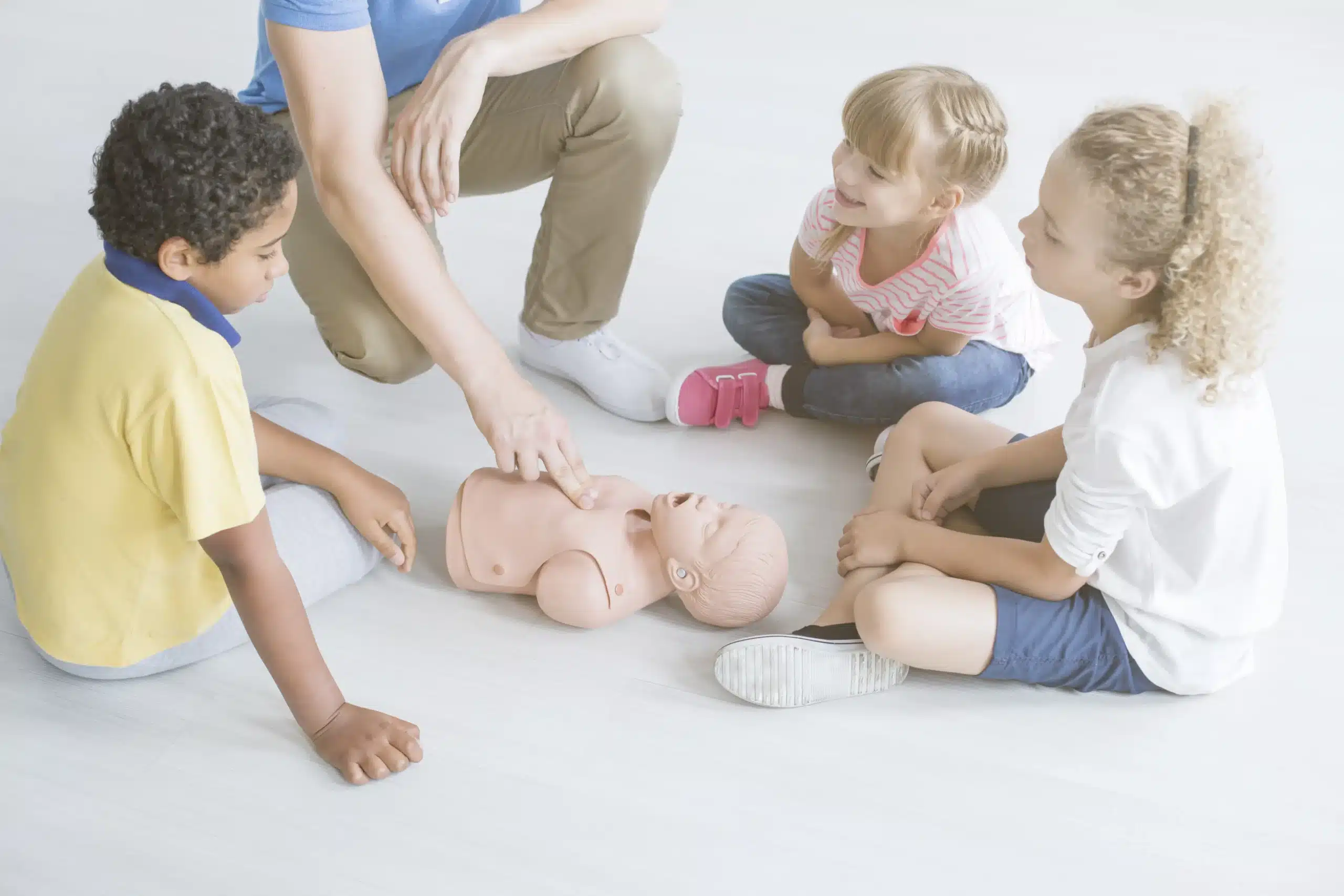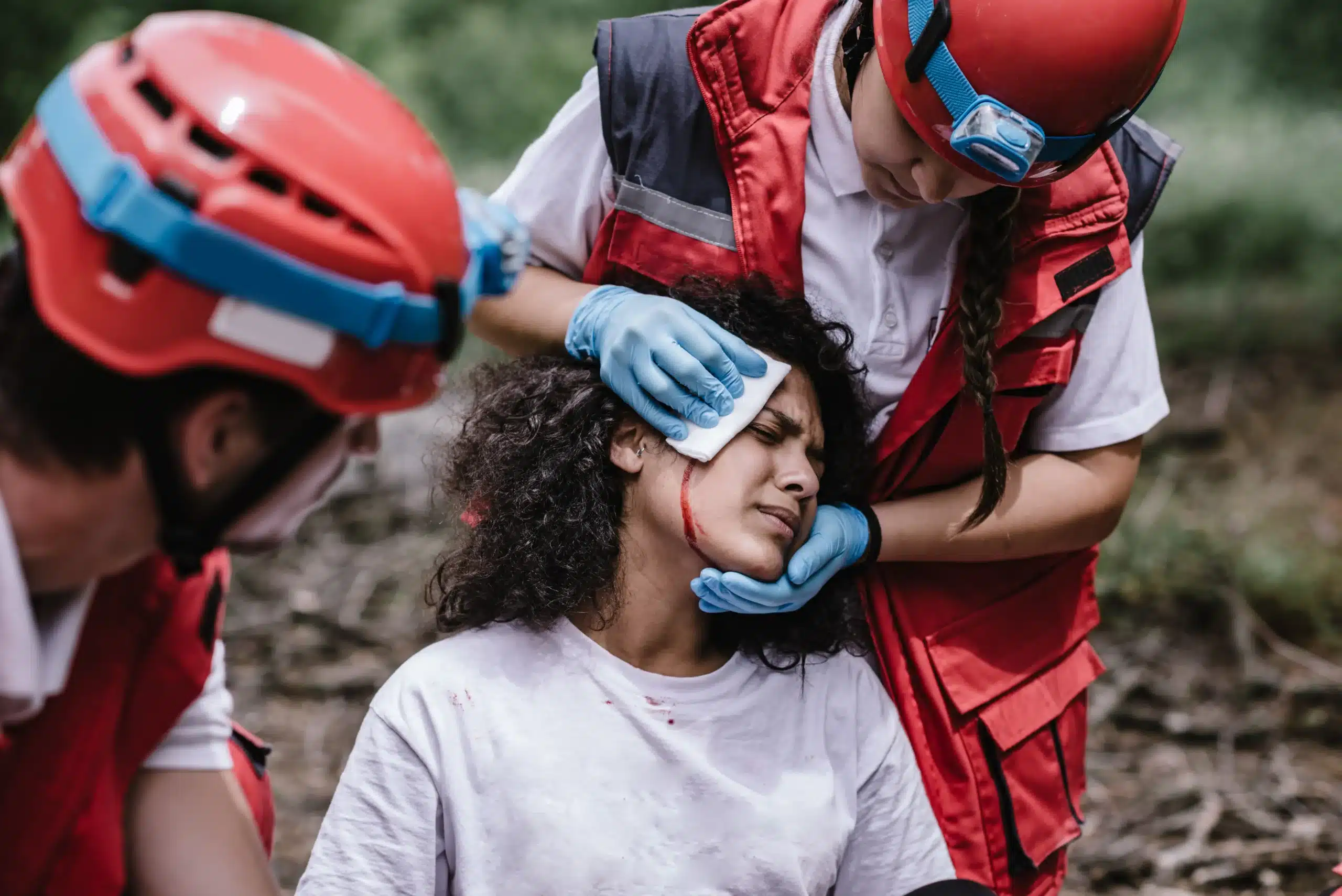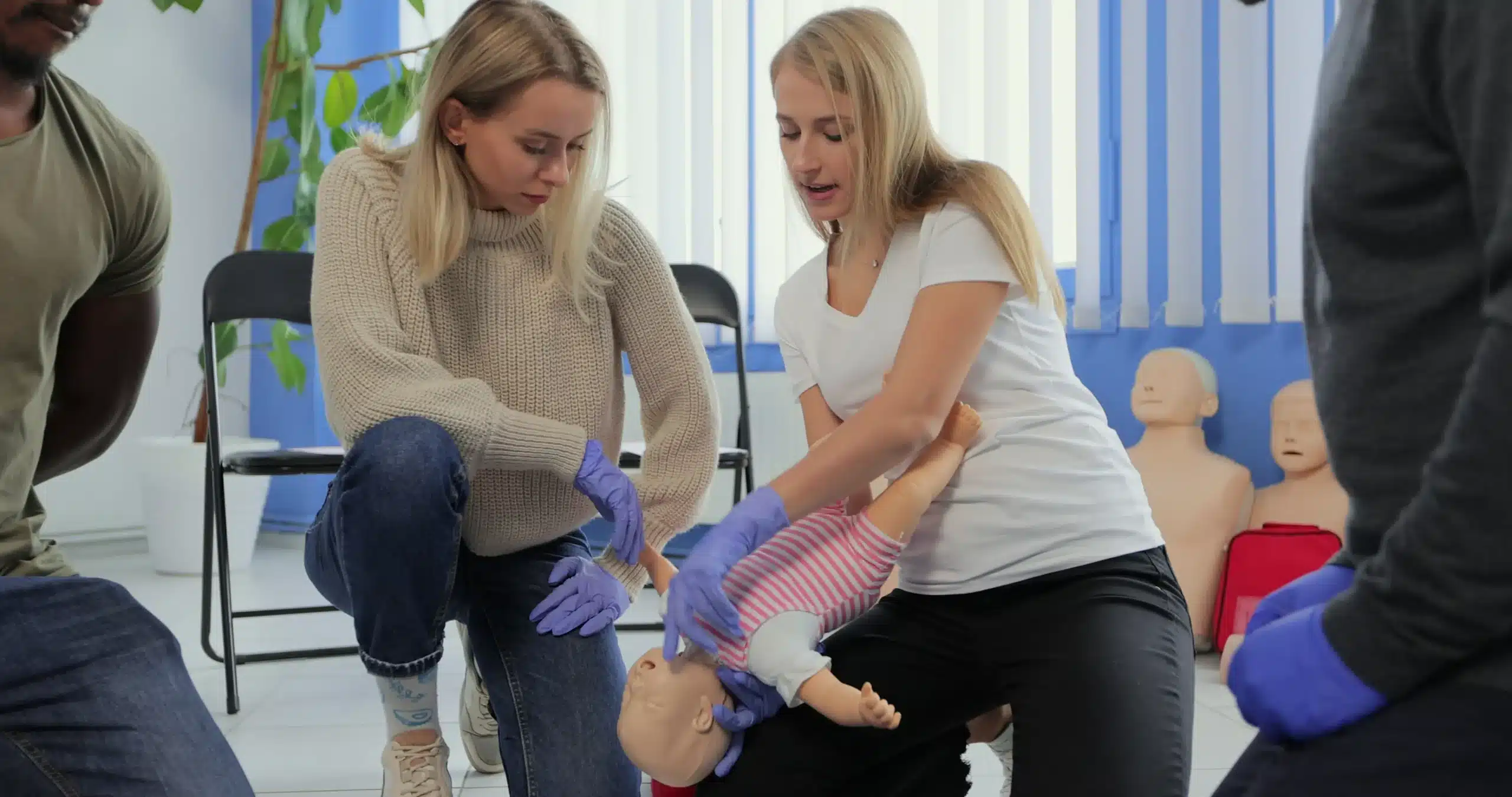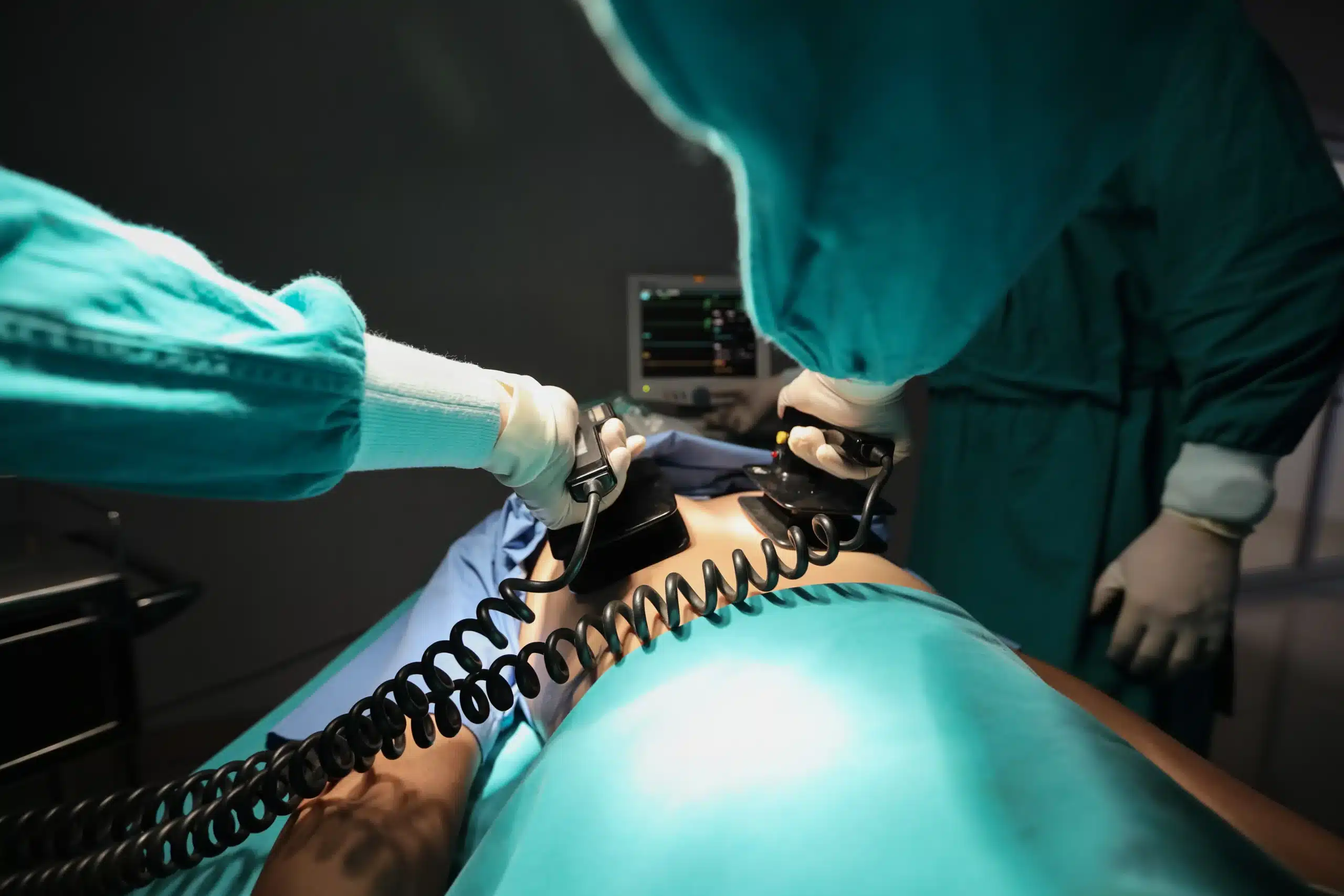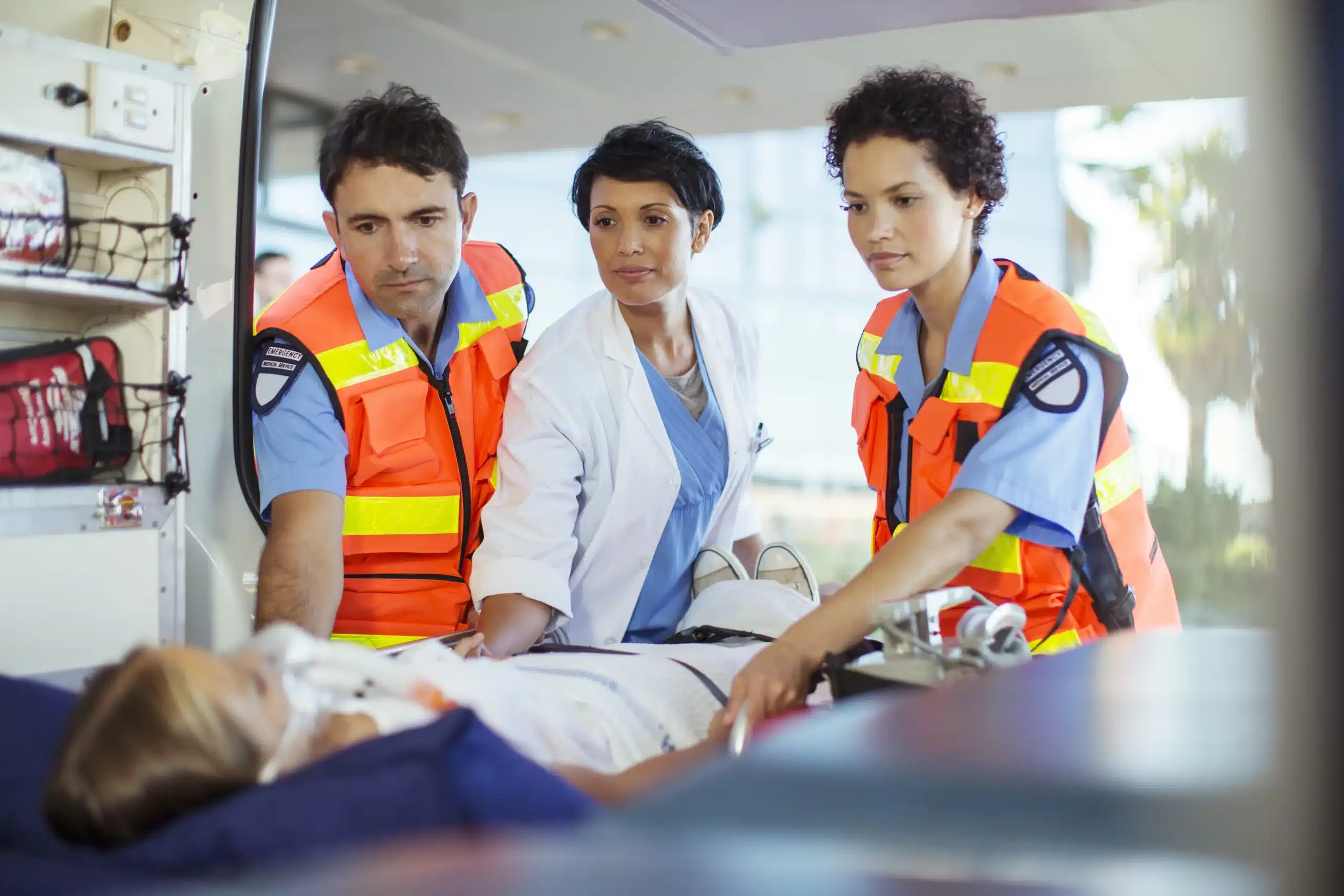In a medical emergency, seconds can matter. CPR can double or triple a person’s chance of survival, making it a skill worth having. If you’ve been searching for “CPR certification near me,” this comprehensive guide is here to help. We’ll explore the different types of CPR certification, top providers in your area, what to expect during training, and how to maintain your skills. Whether you’re a healthcare professional, a childcare provider, or simply someone who wants to be prepared, this guide will empower you to take action and make a difference.
Key Takeaways
- CPR certification is a life-saving skill: Equipping yourself with CPR training empowers you to respond effectively during emergencies and significantly improves the chances of survival for someone experiencing cardiac arrest.
- Find the right CPR class for you: Consider various factors like course content, cost, location, and the instructor’s experience when selecting a CPR course. Choose a program that aligns with your learning style and schedule.
- Stay current with your CPR skills: Maintain your CPR certification by renewing it every two years and staying informed about updated guidelines. Regularly practicing your skills ensures you’re always prepared to act confidently in a crisis.
What is CPR Certification & Why You Need It?
CPR certification means you’ve successfully completed a course and proven your ability to perform cardiopulmonary resuscitation (CPR). It equips you to respond effectively during medical emergencies when someone’s breathing or heartbeat has stopped. But why is it so important, and who needs it? Let’s take a closer look.
What is CPR and why is it important?
CPR involves chest compressions and rescue breaths to circulate oxygenated blood when the heart isn’t pumping effectively. Learning CPR is more than just technique; it empowers you to make a real difference in a life-or-death situation. Studies show that effective CPR can double or even triple a person’s chance of survival after cardiac arrest. Your quick actions could be critical, giving first responders valuable time to arrive.
Who needs CPR certification?
While healthcare professionals like doctors and nurses benefit from CPR certification, its importance goes beyond hospitals. Anyone in healthcare—from medical assistants and CNAs to physical therapists—should consider getting certified. But it doesn’t stop there. Teachers, coaches, childcare providers, lifeguards, and even parents—anyone who regularly interacts with others can benefit from these skills. CPR certification is valuable in many professions and empowers people to respond confidently during emergencies. Even if you never use your CPR skills, the confidence of being prepared is invaluable. Knowing you can act in a crisis makes a difference, not just for the person needing help, but for you too. CPR classes at Safety Training Seminars in Livermore equip you with the skills and confidence to act quickly and effectively. We offer various courses, including CPR and First Aid Certification, to fit your needs. We also offer discount group classes and the innovative RQI program for quick certification. Our low price guarantee ensures you’re getting the best value for your training.
Types of CPR Certification Courses
When it comes to CPR certification, you have options. Let’s break down the three main types of courses: in-person, online, and blended learning. Each format has its own advantages, so understanding the differences can help you choose the best fit for your learning style and schedule.
In-Person CPR Classes
Traditional in-person CPR classes offer a hands-on learning experience. Led by certified instructors, these courses provide real-time feedback and personalized guidance as you practice essential CPR techniques. This direct interaction can be invaluable, especially for those who learn best in a structured, classroom setting. Instructors can demonstrate proper form, correct mistakes immediately, and answer your questions thoroughly. Plus, practicing with other students can build confidence and create a supportive learning environment. Many providers offer various class schedules to accommodate busy lives.
Online CPR Courses
If your schedule is packed or you prefer learning at your own pace, an online CPR course might be a good fit. These courses often use video demonstrations and interactive quizzes to make learning engaging and effective. You can study anytime, anywhere, and revisit materials as needed. Online courses offer flexibility and convenience, making them a popular choice for those balancing work, family, and other commitments. Keep in mind that online courses typically only cover the cognitive portion of CPR training. You’ll need an in-person skills session for full CPR certification.
Blended Learning CPR Courses
Blended learning combines the best of both worlds. You’ll complete the cognitive coursework online at your own convenience, then attend a shorter, in-person session to practice your skills and receive instructor feedback. This format offers flexibility while still ensuring you get the hands-on experience crucial for performing CPR effectively. Blended learning is a great option for those who want a more personalized learning experience and appreciate the convenience of online learning combined with the benefits of in-person instruction. When choosing a blended learning course, research the training company’s accreditation, instructor qualifications, and overall reputation.
Top CPR Certification Providers Near You
Finding the right CPR certification provider is crucial for receiving high-quality training. Here are some of the leading organizations offering CPR certification courses:
American Heart Association (AHA)
The American Heart Association (AHA) is a leading authority on CPR training and research. They offer a wide range of courses, from Basic Life Support (BLS) for healthcare providers to Heartsaver courses for the general public. AHA certifications are widely accepted and recognized. Their focus on evidence-based practices ensures you learn the most up-to-date techniques. AHA courses often include hands-on practice and interactive learning, giving you the confidence to respond effectively in real-life emergencies.
American Red Cross
The American Red Cross is another well-respected provider of CPR certification. They offer various courses designed for different audiences, including individuals, families, and workplace groups. Red Cross certifications are nationally recognized and meet OSHA requirements. Their training programs emphasize practical skills and real-world scenarios, preparing you to handle emergencies confidently.
Safety Training Seminars
Safety Training Seminars provides American Heart Association (AHA) certified courses in CPR, First Aid, BLS, ACLS, and PALS. They offer flexible scheduling and competitive pricing, making it convenient and affordable to get certified. Serving the Livermore, Dublin, and Mountain House areas of California, Safety Training Seminars focuses on delivering high-quality instruction with a commitment to student success. Check out their low price guarantee. They also offer EMSA Child Care Health and Safety training and discount group classes. For quick certification, consider their innovative RQI program.
National Safety Council
The National Safety Council (NSC) is a trusted source for safety training and certifications. They offer comprehensive CPR and first aid courses that meet national standards. NSC certification is widely accepted by employers and organizations. Their training programs often incorporate interactive elements and simulations to enhance learning and retention.
ProCPR
ProCPR offers flexible online and in-person CPR certification courses. Their blended learning options combine online instruction with hands-on skills sessions. ProCPR certifications are nationally accredited and meet OSHA requirements. Their focus on convenient and accessible training makes it easier for individuals to get certified and maintain their skills.
Choose the Right CPR Course
Finding the right CPR course means considering a few things to make sure it fits your needs and learning style. Here’s what to keep in mind:
Course Content & Curriculum
CPR courses are designed for different people and professions. Healthcare providers, for instance, typically need more advanced training than someone wanting basic CPR certification for personal knowledge. Look for courses from accredited providers like the American Heart Association (AHA) or the American Red Cross—they base their training on recognized guidelines. Make sure the curriculum covers essential skills like chest compressions, rescue breaths, using an AED, and choking relief. Our courses cover all of these life saving techniques.
Certification Validity & Renewal
CPR certifications are usually good for two years. Keep renewal requirements in mind when choosing a course. Some providers make recertification easier, which can save you time later. Knowing the validity period helps you stay current with your qualifications. Our certifications are valid for two years, and we offer convenient renewal options.
Cost & Budget-Friendly Options
CPR course costs vary based on the provider, location, and course type. Find options within your budget, and remember some organizations offer discounts for groups or certain demographics. While cost matters, the quality of the training should be your priority. Most basic CPR courses don’t require prior knowledge, but it’s always a good idea to check for prerequisites, especially for advanced classes. Check out our website for more information on our discount group classes. We also offer a low price guarantee.
Location & Convenience
Think about the course location and schedule. In-person classes offer hands-on learning, while online courses are more flexible for busy schedules. Blended learning combines online modules with in-person skills sessions, offering a mix of both. Compare course schedules and formats to see what fits your lifestyle. We’re conveniently located for anyone in the Dublin, Livermore, and Mountain House areas.
Instructor Qualifications & Experience
A qualified instructor is key to effective training. Ask about the instructor’s certifications, experience, and teaching style. A good training company provides post-training support, like refresher courses and access to updated resources. This helps you maintain your skills and stay up-to-date on the latest CPR guidelines. Learn more about finding the right training company. At Safety Training Seminars, we’re committed to excellent customer service and top-notch instruction.
What to Expect During CPR Training
Getting CPR certified is a rewarding experience, and knowing what to expect can make you feel more prepared. CPR training blends theory with hands-on practice, ensuring you gain the confidence to act in a real emergency. At Safety Training Seminars, we’re committed to providing high-quality training that equips you with the skills and knowledge to make a difference.
Hands-on Practice & Skill Development
CPR training isn’t just about memorizing facts—it’s about developing crucial skills. You’ll learn the essential techniques of CPR, including chest compressions and rescue breaths. Hands-on practice is a core component of any good CPR course. You’ll work with training manikins to get a feel for providing effective chest compressions, learning the correct depth and placement to ensure adequate blood circulation. This hands-on training builds muscle memory and confidence, preparing you to respond effectively under pressure. At Safety Training Seminars in Livermore, we emphasize practical training, giving you ample opportunity to practice these life-saving techniques. We serve the Dublin, Livermore, and Mountain House communities.
Written Exams & Assessment
Most CPR courses include a written exam to assess your understanding of the material. This typically covers topics like recognizing the signs of cardiac arrest, the steps of CPR, and how to use an AED. The exam reinforces what you’ve learned in the course. It’s a way to solidify your knowledge and ensure you’re ready to apply it in a real-life situation. Our instructors at Safety Training Seminars are always available to answer any questions and help you prepare. We offer a range of courses, including CPR and First Aid, EMSA Child Care Health & Safety, and our innovative RQI program for quick certification.
Certification Process & Timeline
Once you’ve successfully completed the course and passed the written exam, you’ll receive your CPR certification. This certification is typically valid for two years. After two years, you’ll need to take a refresher course to stay current with the latest guidelines. The process is straightforward: you enroll in a course, attend the training, and upon successful completion, receive your certification card. CPR certification is valid for two years. At Safety Training Seminars, we make the process as smooth as possible, providing you with all the information you need to get certified and stay certified. We offer a variety of courses to fit your schedule, including discount group classes. Our competitive pricing makes high-quality training accessible to everyone.
Ensure Your CPR Certification is Recognized
Before signing up for a CPR class, take a moment to confirm your certification will be accepted. Understanding industry standards, employer preferences, and how to verify authenticity will save you time and ensure your certification meets the necessary requirements.
Industry-Specific Requirements & Standards
Different industries have specific requirements for CPR certification. Healthcare providers, for example, typically require certifications from nationally recognized organizations like the American Heart Association (AHA) or the American Red Cross. Accredited providers base their training on established guidelines from these organizations, ensuring a high standard of training. Always check with your licensing board or employer to understand which certifications they accept. For those working in childcare in California, the EMSA Child Care Health & Safety training is often a requirement.
Employer Preferences & Acceptance
Even within the same industry, employers may prefer certain CPR certifications. Some might prefer the AHA, while others accept the Red Cross or other reputable certifying bodies. Contact your employer or school directly to determine their preference. This simple step can prevent issues later. If you’re looking for streamlined certification, our RQI program might be a good fit. We also offer discount group classes for businesses looking to certify multiple employees.
Verify Certification Authenticity
With the rise of online CPR courses, verifying your certification’s authenticity is essential. A valid online CPR certification comes from a reputable provider and is recognized by employers and institutions. Check if the provider is accredited by a recognized organization and if the certification aligns with industry standards. At Safety Training Seminars, we maintain a low price guarantee while upholding the highest standards for our training, so you can be confident in your certification’s value and legitimacy. We’re proud to serve Dublin, Livermore, and Mountain House, providing top-tier training. Contact us with any questions about our courses or certification process.
Essential CPR Skills You’ll Learn
CPR doesn’t require extensive medical training. With some practice and the right instruction, you can learn how to perform CPR on an unconscious person and potentially save a life. Here’s a glimpse of the essential skills you’ll acquire during your CPR certification course:
High-quality Chest Compressions
High-quality chest compressions are the cornerstone of effective CPR. You’ll learn the proper hand placement—center of the chest, between the nipples—and the correct depth and rate of compressions to ensure adequate blood circulation. In a hands-on class, you’ll use a CPR training mannequin to practice these techniques and develop the muscle memory needed to perform them confidently in a real emergency. This hands-on training is crucial for mastering the technique and building confidence.
Rescue Breathing Techniques
Along with chest compressions, rescue breathing is a vital component of CPR. You’ll learn how to open the airway and deliver effective rescue breaths, ensuring oxygen reaches the person’s lungs. Your instructor will guide you through the proper techniques and address any questions about CPR.
Using an AED
An AED (Automated External Defibrillator) can significantly increase the chances of survival during cardiac arrest. CPR classes teach you how to quickly and correctly use an AED. You’ll learn to recognize the signs of cardiac arrest, assess the situation, and operate the AED safely and effectively. The use of an AED is often critical in these situations.
Recognize Cardiac Arrest & Respond to Emergencies
CPR training equips you to recognize the signs of cardiac arrest and other medical emergencies. You’ll learn how to assess the scene, determine the appropriate course of action, and respond swiftly and confidently. This rapid response can double or triple a person’s chance of survival. CPR training for healthcare professionals is vital for providing immediate and competent care, which significantly increases the survival rate and improves patient outcomes. For more information on the importance of CPR training, check out this helpful resource.
Choking Relief Methods
CPR certification courses also cover choking relief methods for both adults and children. You’ll learn how to recognize the signs of choking and perform the Heimlich maneuver and other techniques to dislodge the obstruction and restore breathing. These skills are invaluable in various settings, from restaurants to family gatherings.
Find CPR Classes Near You
So, you’re ready to get CPR certified—fantastic! Finding the right class near you doesn’t have to be a struggle. Here’s how to simplify your search:
Online Search Tools & Resources
Start your search online. The Red Cross has a handy search tool that pinpoints CPR/AED certification classes in your area. You can also explore the websites of well-known providers like the American Heart Association (AHA) and Red Cross for in-person and online CPR training. Many training providers list their schedules and course details online, making it easy to compare and choose what works best for you.
Local Community Centers & Organizations
Your local community is another great resource. Check with nearby community centers, schools, or even recreation departments. These organizations often host CPR and first aid courses. Don’t forget to ask around! Friends, family, or colleagues who have recently completed CPR training can offer valuable insights and recommendations.
Workplace Training Opportunities
If you work in healthcare, your employer might offer Basic Life Support (BLS) certification courses. Hospitals and clinics frequently provide these programs for their staff and sometimes even extend them to the community. If you’re part of a larger organization or workplace, see if group training can be arranged. Having multiple classes scheduled or a sufficient number of instructors can make training more convenient and efficient for everyone. For businesses in the Tri-Valley area, including Dublin, Livermore, and Mountain House, Safety Training Seminars offers group discounts and on-site training options. We can help you find the perfect solution for your team’s CPR training needs.
Debunking CPR Certification Myths
One of the biggest roadblocks to getting your CPR certification is misinformation. Let’s clear up some common myths and misunderstandings that might be holding you back.
Addressing Myths & Misunderstandings
It’s easy to get caught up in misconceptions about CPR training. Some people believe they don’t need formal CPR training to perform CPR. While it’s true you don’t legally need certification to help in an emergency, a quality CPR course, like those offered by Safety Training Seminars, ensures you’re prepared to act confidently and effectively. Others worry about performing CPR incorrectly or causing harm. These are valid concerns, but a structured class teaches you the proper techniques, minimizing those risks. And while some hesitate due to the perceived cost or time commitment, remember that many affordable options exist, and the skills you gain are invaluable. Don’t let these myths prevent you from learning this life-saving skill.
In-Person vs. Online Training
Another common question is whether online CPR certification is as good as in-person training. The short answer is: it depends. Fully online CPR courses might offer convenience, but they often lack the crucial hands-on practice component. In-person classes, like those offered at Safety Training Seminars, provide the guided practice and feedback necessary to master essential techniques. A blended learning approach, combining online modules with in-person skills sessions, can be a great option, offering both flexibility and practical experience. For reliable, recognized certification, look for programs that adhere to the latest guidelines from organizations like the American Heart Association. Ultimately, the best choice depends on your learning style and the specific requirements of your workplace or field. If you’re unsure which type of training is right for you, reach out to a certified instructor for guidance.
Maintain Your CPR Skills & Certification
CPR isn’t a learn-it-and-forget-it skill. Staying up-to-date on the latest guidelines and renewing your certification ensures you’re always prepared to help in a crisis.
Renewal Processes & Continuing Education
CPR certifications are typically valid for two years. It’s crucial to renew your certification before it expires to maintain your qualifications. Check with your certifying organization, such as the American Heart Association or the American Red Cross, for specific renewal procedures. Many organizations offer renewal courses, often shorter than the initial certification course, focusing on refreshing essential skills and covering any updates to guidelines. This helps you stay prepared and confident in your abilities.
Stay Updated with the Latest Guidelines
CPR techniques and best practices can evolve. Staying informed about the latest guidelines ensures you’re providing the most effective care possible. Regularly reviewing resources from reputable organizations like the American Heart Association or consulting with experienced CPR instructors can help you stay current. This ongoing education not only strengthens your skills but also reinforces your confidence in responding to emergencies. Even small changes in technique can significantly impact outcomes, so committing to continuous learning is essential for anyone certified in CPR. Staying informed could make all the difference in a life-or-death situation.
Related Articles
- Why CPR is Essential in Healthcare (and How to Get Certified)
- CPR Certification in Dublin: Your Guide – Livermore CPR Classes
- CPR Renewal Dublin: Your Complete Guide – Livermore CPR Classes
- Debunking Common CPR Myths Saving Lives With Facts
- CPR Certification in Livermore: Your Complete Guide – Livermore CPR Classes
Frequently Asked Questions
How long is CPR certification valid? CPR certifications are typically valid for two years. It’s important to renew your certification before it expires to maintain your qualifications and stay up-to-date with the latest guidelines.
What’s the difference between online and in-person CPR training? Online CPR training offers flexibility and convenience, allowing you to learn at your own pace and on your own schedule. However, it often lacks the hands-on practice crucial for mastering CPR techniques. In-person classes provide real-time feedback from instructors and the opportunity to practice on manikins, building confidence and muscle memory. Blended learning combines the benefits of both formats.
Which CPR certification is best? The “best” CPR certification depends on your specific needs. Healthcare providers often require certifications from organizations like the American Heart Association (AHA) or the American Red Cross. For others, certifications from reputable organizations that align with industry standards are generally accepted. Always check with your employer or licensing board to confirm their requirements.
What if I’m nervous about performing CPR in a real emergency? It’s completely normal to feel nervous about using CPR in a real-life situation. That’s why proper training is so important. High-quality CPR courses equip you with the knowledge and hands-on practice necessary to build confidence and reduce hesitation in an emergency. Remember, any attempt at CPR is better than none.
How do I find CPR classes near me? Use online search tools from organizations like the Red Cross or AHA to locate classes in your area. Check with local community centers, hospitals, or workplaces for training opportunities. Word-of-mouth can also be helpful; ask friends, family, or colleagues for recommendations.
